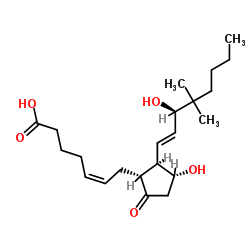Disruption of the Cox-1 gene slows repair of microscopic lesions in the mouse gastric epithelium.
Olga T Starodub, Elise S Demitrack, Heidi K Baumgartner, Marshall H Montrose
Index: Am. J. Physiol. Cell Physiol. 294(1) , C223-32, (2008)
Full Text: HTML
Abstract
Cyclooxygenase-1 (Cox-1) contributes to gastric defense of healthy tissue, but the role in the protection of the gastric epithelium after minor, acute damage has been difficult to study in vivo. Using 710-nm two-photon light absorption to create microscopic gastric damage in anesthetized mice with the gastric mucosal surface surgically exposed and perfused on the microscope stage, the acute response of surface cells to injury could be monitored using in vivo microscopy within seconds after injury. Using exogenous (Cl-NERF) and endogenous fluorophores, extracellular pH and cell death were monitored in real time during the entire damage and repair cycle. Two-photon damage was initiated by scanning approximately 200 microm(2) of gastric surface cells with high laser intensity, causing rapid bleaching of NAD(P)H fluorescence in optically targeted cells. In both Cox-1(+/-) and Cox-1(-/-) mice, a similar initial damage area expanded to include bystander epithelial cells over the next 2-5 min, with larger maximal damage noted in Cox-1(-/-) mice. The maximal damage size seen in Cox-1(-/-) mice could be reduced by exogenous dimethyl-PGE(2). All damaged cells exfoliated, and the underlying epithelium was coincidently repaired over a time interval that was briefer in Cox-1(+/-) (12 +/- 2 min, n = 12) than in Cox-1(-/-) (24 +/- 4 min, n = 14) mice. Directly after damage, pH increased transiently in the juxtamucosal layer (maximal at 3-6 min). A smaller peak pH change was noted in Cox-1(-/-) mice (DeltapH = 0.3 +/- 0.04) than in Cox-1(+/-) mice (DeltapH = 0.6 +/- 0.2). Recovery to normal surface pH took longer in Cox-1(-/-) mice (27 +/- 5 min) than in Cox-1(+/-) mice (12 +/- 1 min). In conclusion, constitutive loss of Cox-1 leaves the gastric mucosa more prone to damage and slowed repair of microlesions.
Related Compounds
| Structure | Name/CAS No. | Molecular Formula | Articles |
|---|---|---|---|
 |
16,16-Dimethyl prostaglandin E2
CAS:39746-25-3 |
C22H36O5 |
|
Lysophosphatidic acid enhances survival of human CD34(+) cel...
2015-01-01 [Sci. Rep. 5 , 16406, (2015)] |
|
Prostaglandin E2--mediated relaxation of the ductus arterios...
2004-10-19 [Circulation 110(16) , 2326-32, (2004)] |
|
Prostanoids regulate angiogenesis acting primarily on IP and...
2015-09-01 [Microvasc. Res. 101 , 127-34, (2015)] |
|
Discovering chemical modifiers of oncogene-regulated hematop...
2009-04-01 [Nat. Chem. Biol. 5 , 236-43, (2009)] |
|
Chronic prostaglandin E2 treatment induces the synthesis of ...
2010-10-01 [J. Neurochem. 115(2) , 363-72, (2010)] |